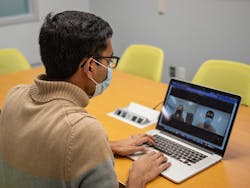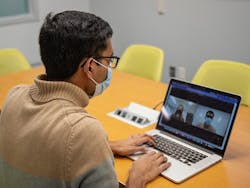How Online Learning Affects Engineering Student Identities
When engineering students shifted to online learning in the early part of March 2020, they were abruptly displaced from the expectation of the hands-on, project-based, design-oriented, active learning associated with in-class engineering lectures and labs.
Despite their perceptions and familiarity with online learning, the majority of students were not prepared to transition to an online learning system. Students and educators alike questioned whether the online environment would be conducive to a deep level of learning.
Sandeep Krishnakumar, an industrial engineering doctoral candidate in the Department of Industrial and Manufacturing Engineering at Penn State University, argues that the online learning experience during the onset of the COVID-19 crisis cannot be compared to typical online learning environments. Instead, an examination of the atypical learning environment during the pandemic can be better served by viewing it through the lens of telework. Moreover, the distinction is imperative in informing best practices for both online and physical classrooms, he said.
Krishnakumar, along with a team of interdisciplinary researchers at Penn State University, documented the findings of their investigation into the experience of first-year engineering students during the shift to online learning and its effect on their capacity to thrive. The paper is published in the Journal of Engineering Education.
Online Learning Attributes
Under usual circumstances, successful online courses are underpinned by robust technical infrastructure that are developed over months or years of instructional design and resources and are backed by evidence-based methods, such as best practices for online instruction. Beneficial elements include self-pacing and flexibility over engagement in course material, and students’ levels of motivation are also regarded as advantages.
Moreover, online learning curricula are based on the assumption that learners choose this mode of learning. “But in 2020, we saw none of that,” said Krishnakumar. “Instead, classes that were meant to be in a physical classroom with instructors and classmates were shifted online.”
Engineering courses require hands-on components and project-based assignments that can be disadvantaged by online classroom dynamics, noted Krishnakumar. Since the requirements for successful online learning were largely unmet, it was unclear how students’ classroom experiences would be shaped through the transition to online learning at the onset of the pandemic, he said.
Applying a Telework Lens
The unexpected timing and speed of the transition, as well as the fact that students did not choose to learn online, render theories about online learning inapplicable, said Krishnakumar.
Telework is a better framework for evaluating the learning experience during the early days of the pandemic because it more accurately captures the work arrangements—such as appropriate workspaces, technology and life balance. However, the telework framework is not without limitations, he said, as the research on forced telework on worker experiences remains scant.
The research team surveyed 121 students in an introductory engineering course and conducted follow-up interviews with 13 students. The cornerstone course is an introductory engineering class that has hands-on, project- and teamwork-oriented components and is required for first-year engineering students. Krishnakumar noted that the skills acquired through this course would be “similar to what design practitioners work on in real-world scenarios.”
Students in this course, for example, worked on design projects that mimic what design practitioners would work on in real-world engineering scenarios. They acquire skills that are crucial to the remaining years of their education, said Krishnakumar, but also learn to execute on the design process from start to finish—from how to frame the design problem, to gathering the needs of the users, building a prototype and obtaining feedback from users.
“Prior work has shown that these kinds of courses are important for increasing the self-advocacy of students that don’t have previous experience,” he said. “We were interested in seeing what the online experience does to their perception of what an engineer does and what design actually is.”
Fostering Engineering Identities
The research team applied workplace thriving theory to draw conclusions about students’ learning experiences. According to this framework, “thriving” refers to a state of engagement requiring both “vitality” (a person’s capacity to feel energized by their work) and “learning” (whereby individuals feel they have developed knowledge and skills).
The framework is particularly useful because it is centered on adult learners with multiple aspects of “real life” to attend to. Reframing the virtual classroom as a remote work environment and viewing the student through the lens of a teleworker enabled the researchers to identify markers that may be detrimental to worker outcomes, such as productivity, satisfaction, or interpersonal relationships with peers and teachers.
The responses highlighted differences among learners and showed that many students’ social relationships suffered due to the pandemic. Some were able to compensate for the loss through teamwork, while others struggled to foster connections with fellow learners and instructors and found that their engagement in the class waned.
“This underscores the need for interpersonal relationships in the engineering classroom, because vitality—and therefore thriving—depends in part on the capability to relate to others,” Krishnakumar said.
Another observation related to students’ perceptions of the role of an instructor. “Students saw instructors not only as people who were introducing them into the world of engineering, but as people who could introduce them to research opportunities and other opportunities in the college of engineering,” said Krishnakumar.
Some students articulated developing other crucial skills due to barriers imposed by the pandemic. “It had to do with how people were able to reframe their experiences,” said Krishnakumar. “There were students, for example, who said they had to figure out how to build a prototype at home, or collaborate with other people without being in the same room. When they were able to approach these obstacles as problem-solving—which is what engineers do every day—they were able to reframe their experience and accept that it was a different kind of learning that still contributed to their development as an engineer.”
There’s a tension with the autonomy that is inherently characteristic of the online learning environment, the need for self-regulation in these environments and the intrinsic motivation fostered when students can visualize their future selves, pointed out Krishnakumar. Some students were thriving relative to those who were holding onto the idea of learning specific skills, such as woodworking, in a physical classroom, he said.
The observations raise an important implication for future educators, said Krishnakumar. “They will be challenged to teach students that the problems they face—either in the classroom or online—can be viewed as obstacles, but that these are also opportunities for problem-solving that could contribute to their thriving.”
Editor’s Note
Catherine Berdanier, the Clyde W. Shuman Jr. and Nancy Shuman Early Career Assistant Professor of Mechanical Engineering, and Sarah Ritter, associate teaching professor in the School of Engineering Design, Technology and Professional Programs, with Penn State; Torsten Maier, assistant professor of industrial engineering at Kettering University; and Christopher McComb, associate professor of mechanical engineering at Carnegie Mellon University, also contributed to the paper.
About the Author

Rehana Begg
Editor-in-Chief, Machine Design
As Machine Design’s content lead, Rehana Begg is tasked with elevating the voice of the design and multi-disciplinary engineer in the face of digital transformation and engineering innovation. Begg has more than 24 years of editorial experience and has spent the past decade in the trenches of industrial manufacturing, focusing on new technologies, manufacturing innovation and business. Her B2B career has taken her from corporate boardrooms to plant floors and underground mining stopes, covering everything from automation & IIoT, robotics, mechanical design and additive manufacturing to plant operations, maintenance, reliability and continuous improvement. Begg holds an MBA, a Master of Journalism degree, and a BA (Hons.) in Political Science. She is committed to lifelong learning and feeds her passion for innovation in publishing, transparent science and clear communication by attending relevant conferences and seminars/workshops.
Follow Rehana Begg via the following social media handles:
X: @rehanabegg
LinkedIn: @rehanabegg and @MachineDesign

